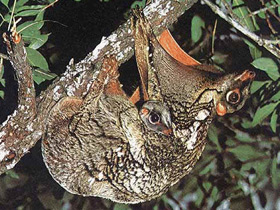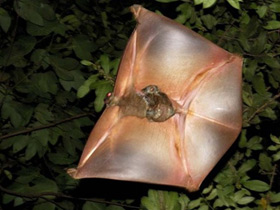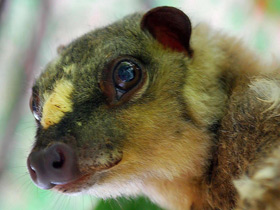The Philippine flying lemur or Philippine colugo (Cynocephalus volans)
The Philippine flying lemur or Philippine colugo (Cynocephalus volans), known locally as kagwang, is one of two species of colugo or "flying lemurs". It is monotypic of its genus. Although it is called "flying lemur", the Philippine flying lemur is neither a lemur nor does it fly. Instead, it glides as it leaps among trees.
Cynocephalus volans is one of two species of flying lemurs. It is endemic to the Philippines, where its population is concentrated in the Mindanao region and Bohol. Despite its name, it is not a lemur; in fact, it is not even a primate.
The body of the Philippine flying lemur is about 30 cm long, and they have a membrane that joins the legs and tail, the patagium, leaving only the head free, which allows them to glide over several tens of metres when they jump from tree to tree. When unfolded, this membrane can reach 60cm in width, forming a sort of parachute. The total length, including tail, is 77 to 95 cm in adulthood and a weight of 1 to 1,750 kg.34
The coat is thick and soft, greyish in colour, with reddish-brown tones. To allow for good camouflage in trees, it has white speckles on the back, and a golden or yellowish tinge on the belly area. The related Malaysian species (Galeopterus variegatus) is a lighter shade of grey, with more white speckles than the Philippine species.
Its legs have five toes with strong, short, curved claws to ensure a good grip on tree bark, and the forelimbs are prehensile. In order to further increase the total surface area of the patagium, even the spaces between its toes are webbed.
The head has a certain resemblance to that of a dog. The Philippine flying lemur has excellent night vision thanks to its large round eyes. The dentition is primitive. They have the peculiarity of having comb-like incisors that are used both to tear vegetables and to care for their skin.
Behaviour
The Philippine flying lemur is arboreal and nocturnal, and usually resides in primary and secondary forests, but some wander into coconut, banana, and rubber plantations as deforestation for farming and industry is an increasingly prevalent problem. The colugo sleeps in hollow trees or clings onto branches in dense foliage during daytime. When they engage in this hanging behaviour from branches, they keep their heads upright, unlike bats.
On the ground, colugos are slow and clumsy, and not able to stand erect, so they rarely leave the canopy level of the forest, where they glide from tree to tree to get to food or their nests, which are also high in the trees. In the trees, though, colugos are quite effective climbers, though they are slow; they move in a series of lingering hops as they use their claws to move up the tree trunk. Foraging only at night, colugos on average forage for 9.4 minutes about 12 times per night. They typically leave their nests at dusk to begin their foraging activity. When foraging, returning to the nest, or just moving around, the Philippine flying lemur uses its patagium to glide from tree to tree. The patagium is also used for cloaking the colugo when it is clinging to a tree trunk or branch, and sometimes it is even seen curled up in a ball, using its patagium again as a cloaking mechanism among palm fronds often in coconut plantations.
Colugos maintain height in the trees to avoid predators that may live in lower levels, but they are still susceptible to other predators that can reach these higher levels of the canopy and predatory birds that can attack from above. They live alone, but several may be seen in the same tree, where they maintain their distance from one another and are very territorial of their personal areas. Though they are not social mammals, they do engage in a unique semi-social behaviour where colugos living in the same relative area or tree follow each other's gliding paths through the trees in search of food. This may be a defence mechanism, whereas a population, the safest route possible is determined and shared as a sort of cooperative mechanism for increased survival rates. The only time colugos actually live socially is after a mother has given birth; then she will care for and live with her offspring until they are weaned; at that point, the offspring are on their own. The average lifespan of the Philippine flying lemur is unknown.
Diet
The Philippine flying lemur is a folivore, eating mainly young leaves and occasionally soft fruits, flowers, plant shoots, and insects. They also obtain a significant amount of their water from licking wet leaves and from the water in the plants and fruits themselves. Most of their nutrition is obtained by jumping and gliding between trees high in the canopy; rarely do they eat on the forest floor.
Reproduction
Little is known about the reproductive behaviour in colugos. The female usually gives birth to one young after a two-month gestation period. The young is born undeveloped and helpless, and it attaches itself to its mother's belly, in a pouch formed from the mother's tail membrane. It is eventually weaned around 6 months old, and leaves its mother's patagium. Adult size and sexual maturity is reached between two and three years of age. Mating usually occurs between January and March.
Major threats
The Philippine flying lemur is threatened by massive destruction of its forest habitat, owing partly to logging and the development of land for agriculture.


















































